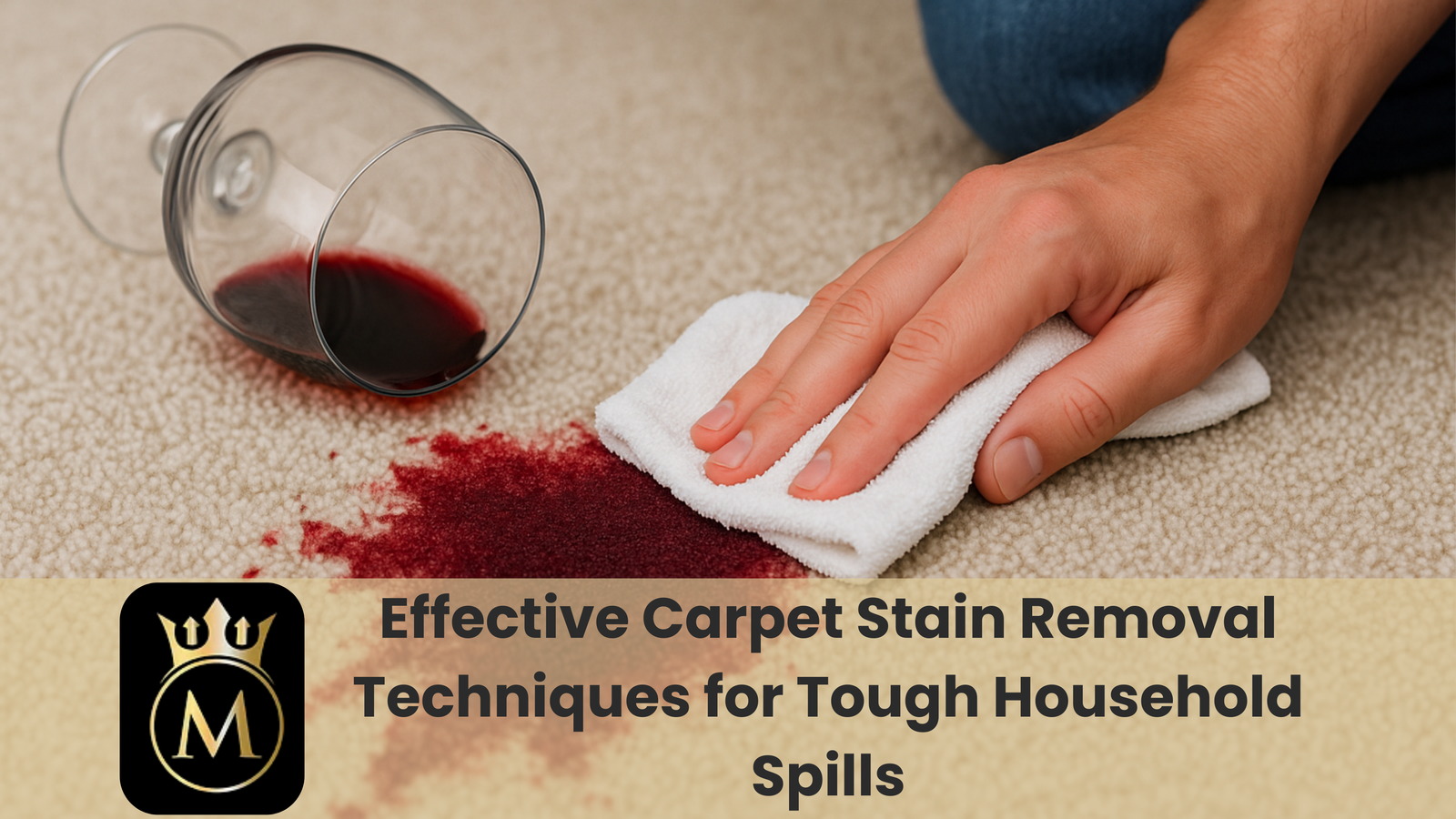Carpet stains are an inevitable part of everyday life. Whether it’s red wine, coffee, pet accidents, or ink, stubborn spills can quickly tarnish your home’s appearance and lead to lingering odors if not addressed properly. Knowing the right techniques and having the proper tools on hand will help you conquer tough stains before they become permanent. This guide outlines step-by-step methods, recommended cleaning agents, and preventative tips to keep your carpets looking fresh and vibrant.
1. General Preparations Before Tackling Any Stain
1.1 Act Quickly
The longer a stain sits, the more it bonds with carpet fibers. As soon as the spill occurs, grab a clean, white cloth or paper towel and gently blot the area. Avoid rubbing; rubbing forces liquid deeper into the pile and can spread the stain to surrounding fibers. Instead, use a blot-and-lift motion.
1.2 Gather Essential Supplies
Before starting, assemble these items:
- White microfiber cloths or paper towels: Colored or printed fabrics can transfer dyes onto the carpet.
- Spray bottles: Ideal for diluting solutions and applying cleaning solutions evenly.
- Soft-bristled brush: To gently agitate cleaner into fibers without causing damage.
- Bowl or bucket: For mixing DIY cleaning solutions.
- Vacuum cleaner: With a HEPA filter to remove any leftover dry debris once the stain is treated and dry.
1.3 Test Cleaning Agents on an Inconspicuous Area
Always spot-test any cleaning solution on a hidden section (such as underneath a furniture leg) to ensure it won’t discolor or damage the carpet. Apply a small amount of the solution, blot with a white cloth, and wait 5–10 minutes to check for any adverse effects.
2. Oil- and Grease-Based Stains
2.1 Blot Excess Grease
Using a dry, absorbent white cloth, gently blot up as much liquid grease or oil as possible. Do not rub, as this can push the oil deeper into the fibers.
2.2 Apply Dry-Cleaning Solvent or Baking Soda
- Dry-cleaning solvent: Dampen a white cloth with a commercial dry-cleaning solvent (petroleum-based). Blot the stained area from the outside edges inward to avoid spreading.
- Baking soda or cornstarch: Sprinkle a generous layer of baking soda or cornstarch over the stain. Let it sit for 15–20 minutes to absorb lingering oil. Vacuum thoroughly.
2.3 Use a Mild Dish Soap Solution
- Mix 1 teaspoon of clear, grease-cutting dish soap (avoid dyes or bleach) with 1 cup of warm water in a spray bottle.
- Lightly mist the stain and let it sit for 5 minutes.
- Gently agitate with a soft-bristled brush, working in small circles.
- Blot with a clean, damp cloth to lift the detergent and dissolved grease.
- Rinse by spraying clean water and blotting until no soap residue remains.
2.4 Final Blot and Dry
Blot one last time with a dry microfiber cloth, then allow the carpet to air dry. If possible, position a fan nearby to speed up drying and prevent mildew growth.
3. Protein-Based Stains (Blood, Dairy, Pet Urine)
3.1 Remove Solids and Blot Liquids
If the stain is fresh, carefully lift any solids using a spoon or dull knife. Blot excess liquid with a white cloth without rubbing.
3.2 Apply an Enzyme Cleaner
Protein stains break down into amino acids that bacteria feed on, causing odors. Enzyme-based cleaners are formulated to digest organic compounds:
- Spray the enzyme cleaner directly onto the stain, saturating it thoroughly.
- Allow the cleaner to dwell for 10–15 minutes, check the manufacturer’s instructions for optimal dwell time.
- Gently blot with a white cloth to transfer lifted residue.
3.3 Rinse and Neutralize Odors
- Rinse the area with a solution of 1 tablespoon of white vinegar and 2 cups of warm water. Vinegar helps neutralize residual odors and balances pH.
- Blot with a damp cloth until the solution is gone.
- Finish by blotting with a dry cloth and letting it air dry completely.
4. Red Wine, Coffee, and Other Dye-Based Stains
4.1 Blot, Don’t Scrub
Immediately blot up excess liquid using a white cloth. Avoid rubbing, as it spreads the dye.
4.2 Salt or Club Soda Method (For Fresh Spills)
- Salt: Generously cover the spill with kosher salt. The salt crystals draw liquid out of the fibers. Let it sit for 5–10 minutes, then vacuum.
- Club soda: Pour club soda onto the stain and blot with a clean cloth. The carbonation helps lift the dye. Continue alternating misting and blotting until the stain lightens.
4.3 Hydrogen Peroxide and Dish Soap
- Mix 1 tablespoon of clear dish soap with 2 cups of hydrogen peroxide (3% solution) in a spray bottle.
- Lightly mist the stain, avoid oversaturating, and allow it to sit for 5–7 minutes.
- Gently blot with a white cloth. The hydrogen peroxide acts as a mild bleaching agent, so always test first in an inconspicuous area.
- Rinse with clean water and blot to remove residue, then allow to air dry.
5. Ink, Marker, and Permanent Marker
5.1 Blot with Isopropyl Alcohol
- Dampen a cotton ball or white cloth with 70% isopropyl alcohol (rubbing alcohol).
- Blot the stained area, transitioning from the outer edge inward to prevent spreading. The alcohol dissolves ink pigments.
- Replace cotton balls or cloth sections as they absorb ink to avoid reapplying the stain.
5.2 Apply a Commercial Solvent-Based Spotter
If rubbing alcohol is insufficient:
- Use a manufacturer-approved solvent spot cleaner designed for ink.
- Spray or apply sparingly; let it dwell per instructions.
- Gently blot with a clean cloth until the ink transfers.
- Rinse with mild dish soap solution (1 teaspoon dish soap in 2 cups water) and blot dry.
6. Gum, Wax, and Sticky Substances
6.1 Freeze and Scrape
- Place a sturdy plastic bag filled with ice cubes directly on top of the gum or wax. Leave for 5–10 minutes until hardened.
- Use a dull knife or plastic scraper to lift the frozen residue carefully.
6.2 Solvent Removal or Iron Technique (Wax)
- Solvent method: Dab a small amount of dry-cleaning solvent onto a cloth and blot the remaining residue.
- Iron method: Place a brown paper bag or clean cloth over the wax stain. With the iron on a low-heat, no-steam setting, gently run over the cloth. The heat melts the wax, which transfers to the paper or cloth. Keep the iron moving to avoid burning the carpet fibers.
7. Preventative Measures and Final Tips
7.1 Use Area Rugs and Entry Mats
Strategically placing mats and rugs in high-traffic zones and entryways traps dirt, moisture, and spills before they reach the carpet.
7.2 Implement a No-Shoes Policy
Encourage family members and guests to remove their shoes indoors. Heel marks, mud, and tracked-in contaminants are major contributors to carpet soiling.
7.3 Schedule Regular Professional Cleanings
Even with meticulous spot treatment, professional deep cleaning (hot water extraction) every 6–12 months flushes out embedded dirt and refreshes carpet fibers. Professional services also apply protective treatments (e.g., stain guard) that repel future spills.
7.4 Keep a Spot-Cleaning Kit Handy
Store a caddy stocked with white cloths, a spray bottle of mild dish soap solution, a bottle of enzyme cleaner, isopropyl alcohol, and a soft brush near living areas. Quick access ensures swift action when spills occur.
8. Conclusion
Tough household spills don’t have to spell disaster for your carpets. By acting quickly, selecting the right cleaning agents, and following proven techniques, such as enzyme treatment for protein-based stains, blotting with isopropyl alcohol for ink, and using salt or club soda for red wine, you can remove most blemishes without professional intervention. However, regular professional cleanings remain essential for deep extraction and long-term carpet care. Armed with these stain removal strategies and preventative best practices, you can keep your carpets looking immaculate and extend their lifespan.








2 Responses